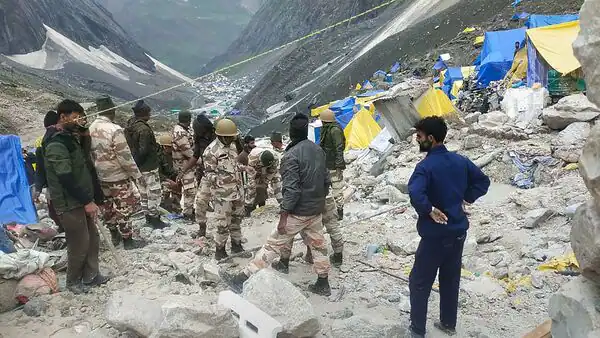People Stranded In The Lahaul-Spiti District
Context:
Even as torrential rain stopped on Wednesday, speeding up the rescue efforts, at least 293 people remained stranded in the Chandertal Lake region in the Himachal Pradesh tribal district of Lahaul-Spiti. To assess the damage brought on by the persistent rain, Chief Minister Sukhvinder Singh Sukhu flew over Sissu, Chandertal, and Losar in the tribal Lahaul-Spiti district and Manali region of Kullu district.
What do we know of Lahaul-Spiti?
- Kyelang in Lahaul serves as the administrative hub.
- Before the merger, the capitals of Lahaul and Spiti were respectively Dhankar and Kardang.
- Geographically, the district is situated between the Tibetan Plateau and the Himalayas.
- Through the Rohtang Pass and the Kunzum Pass, it is connected to Manali and the Spiti Valley, respectively.
- With an average elevation of 4,270 meters, Spiti is a deserted, arid alpine region.
- Southeast of the Sutlej River, the Spiti River passes through a gorge.
- The region shares a strong cultural bond with Tibet’s Ngari Prefecture.
- The Lahaul and Spiti district is renowned for its historic monasteries, charming rural communities, and lively regional celebrations.
- It has a low population density and is the fourth least populated district in India.
Which Tribes are situated in Lahaul-Spiti?
- Origin and population:
-
-
- The Lahaula tribal group is mainly concentrated in Himachal Pradesh’s Lahaul and Spiti districts.
- They are of mixed ancestry and are thought to have Tibetan and indigenous Munda tribe ancestry.
- The community can be found in places like Lahaul Valley, Pattan, Chamba-Lahaul, and the lower Mayar valleys.
-
- Language and dialects:
-
-
- The Lahaula community uses the Manchati, Manchad, Patni, Chamba, Chamba Lahuli, Lahuli, Swangla, and Changsapa Boli languages.
- Additionally, several Lahaula tribal tribes speak various varieties of this language.
-
- Trade:
-
-
- The bulk of the Lahaula community works in agriculture as their main line of work.
- Some residents of the hamlet are also involved in trading, sending goods to cities like Kolkata (formerly Calcutta) such wheat, barley, and ‘Kuth’, a type of herb.
-
- Social Class:
-
-
- There are top and lower classes in the Lahaula society, which is composed of people from the Brahmin, Thakurs, Lohar, and Dagi tribes.
- In the Lahaula tribal society, conjugal unions between members of the same clan are permitted.
-
- Religion and customs:
-
-
- The majority of the population of the Lahaula group practice a blend of Buddhism and Hinduism.
- An important religious landmark that is frequented by both Hindus and Buddhists is the Trilokinath temple.
-
- Traditional Attire and Ornaments:
-
-
- The Lahaula people have a distinctive sense of style and dress in vibrant clothing as part of their traditional customs.
- Within their culture, traditional decorations have also been given significance.
-
- Cultural Significance:
-
-
- The Lahaula tribal community has a rich cultural past, which includes a variety of dance styles, music genres, fairs, and festivals.
- The distinctiveness and beauty of their community are reflected in these cultural customs.
-
- Scheduled Tribe Status:
-
- The Lahaula community has been recognized by the Indian government’s reservation policy as a Scheduled Tribe as of 2001.
- They are eligible for specific benefits and affirmative action policies in terms of political representation, employment, and education thanks to this designation.
- The reservation program attempts to close the socioeconomic gap and improve the social and economic conditions of neglected people, especially tribes.
What is happening in that region now?
- Situation in the Lahaul-Spiti, Himachal Pradesh, area around Chandertal Lake:
-
-
- Due to significant snowfall and rain, at least 293 individuals were left stranded in the Chandertal Lake region.
- To evaluate the damage brought on by the rain, Chief Minister Sukhvinder Singh Sukhu performed an airborne inspection of the impacted areas, including Sissu, Chandertal, Losar, and Manali.
- The State administration was maintaining the security of the camps housing the trapped people.
- The administration was trying to help and rescue the stranded people despite the difficult circumstances.
- The majority of the tourists and residents stranded in the Spiti Valley had already been evacuated, and it was anticipated that the last few people would soon be saved.
-
- Rescue and relief efforts:
-
-
- Chief Minister Sukhu was personally keeping an eye on the situation and making sure that the stranded individuals received the necessary aid.
- 52 Kullu-bound schoolchildren were successfully rescued by the administration from Sissu, Lahaul.
-
- Impact of Heavy Rainfall in Himachal Pradesh:
-
- From June 24 to July 11, Himachal Pradesh saw 32 instances of flash flooding and 51 landslides.
- 88 individuals died as a result of the natural disasters, and 16 more were listed as missing.





